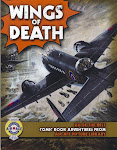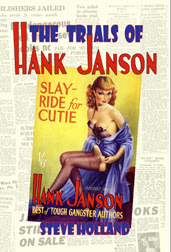 Giorgio Bellavitis, a prolific artist for the British market in the 1950s, died on Thursday, 21 May 2009, of undisclosed causes.
Giorgio Bellavitis, a prolific artist for the British market in the 1950s, died on Thursday, 21 May 2009, of undisclosed causes.Bellavitis, born in Venice in 1926, began drawing at an early age and illustrated some books for the publisher Montuoro and drew vignettes for the humorous weekly Sior Tonin Bonagrazia whilst still at school. He was educated at grammar school and entered the Institute Cavanis, only to have his further education interrupted by war after only a few months. Like all Italian teenagers he was forced into uniform each weekend ("Il sabato fascist" – "fascist Saturday"), something he quickly rejected. With the surrender of Italy to the allies in 1943, Bellavitis travelled to Pordenone with his mother and brother (Michele) to join the partisans, using the nom de guerre 'Walt Disney' (Topolino having been his first great interest in comics) as well as drawing for Vento di montagna [Mountain Wind], a weekly for Venetian partisans.
As the war came to an end, Bellavitis was able to return to his education and his plans for a career in architecture. However, he did not abandon his interest in comics and, after the conflict ended, he resumed his relationship with Mario Faustinelli, who was already established in the world of comics and cartoons. The two had previously thought of working together to put out a comic book and, to that end, brought together a group of Venetian artists and writers to create Uragano Comics Inc. [Hurricane Comics Inc.], best known for the publication of Albo Uragano, later changed to Asso di Picche, something of a legend in Italian comics as it brought together the talents of Hugo Pratt, Dino Battaglia, Alberto Ongaro and others.
 Bellavitis produced his first comic strip for Albo Uragano, 'Robin Hood e gli Allegri Compagni della Foresta', based on the legendary British character. At the time, Bellavitis was signing his work with the pseudonym George Summer.
Bellavitis produced his first comic strip for Albo Uragano, 'Robin Hood e gli Allegri Compagni della Foresta', based on the legendary British character. At the time, Bellavitis was signing his work with the pseudonym George Summer.The venture did not last long and, in 1948, the Venetian Group (as they had become known) split: the majority left to take up an invitation from Argentinian publisher Cesar Civita; only Bellavitis and Dino Battaglia remained in Venice.
Battaglia made contact with the publisher Ave, based in Rome, for whom he went on to draw a number of stories in 1949-50. He subsequently contributed many stories to the newspaper Il Vittorioso, beginning with "Il piccolo domatore" (no.35/1950). These stories stand out particularly because of Bellavitis's passion for architectural design which was visible in much of his work. In 1953, before departing Il Vittorioso, Bellavitis also produced the first 8 pages of the story "La Strada senza Fine" [The Road Without End] for Il Corriere dello Scolaro, completed by Leone Frollo.
 Bellavitis then became art director of Cosmopolitan Artists, an agency headed by Enzo Plazzotta who had moved to London and made contacts with various publishers. Bellavitis himself was one of the first exports, drawing "Paul English" for Swift (1954-55), "Mark the Youngest Disciple" for Eagle (1954-55) and illustrations for Junior Express Weekly. When Cosmopolitan collapsed amidst accusations of financial irregularities in 1955, Bellavitis travelled to the UK and helped set up another agency. In 1955, he had taken the artwork of "Storm Nelson" in Eagle and, in 1956, worked on "Rodney Flood" (Junior Express Weekly) and filled-in briefly on Eagle's "Riders of the Range". A strip planned for Rocket came to nothing when that title was incorporated into Express Weekly after only 32 issues. After this briefly prolific output, and apart from some contributions to Pearsons pocket libraries and to Fleetway's nursery titles, Bellavitis subsequently departed from the British market.
Bellavitis then became art director of Cosmopolitan Artists, an agency headed by Enzo Plazzotta who had moved to London and made contacts with various publishers. Bellavitis himself was one of the first exports, drawing "Paul English" for Swift (1954-55), "Mark the Youngest Disciple" for Eagle (1954-55) and illustrations for Junior Express Weekly. When Cosmopolitan collapsed amidst accusations of financial irregularities in 1955, Bellavitis travelled to the UK and helped set up another agency. In 1955, he had taken the artwork of "Storm Nelson" in Eagle and, in 1956, worked on "Rodney Flood" (Junior Express Weekly) and filled-in briefly on Eagle's "Riders of the Range". A strip planned for Rocket came to nothing when that title was incorporated into Express Weekly after only 32 issues. After this briefly prolific output, and apart from some contributions to Pearsons pocket libraries and to Fleetway's nursery titles, Bellavitis subsequently departed from the British market.During this time, Bellavitis had retained his fan base in Italy through the reprinting of Storm Nelson in Il Giorno dei Ragazzi where his artwork for "La regina d'oro" (originally "The Quest of the Golden Queen") storyline began appearaing from 4 June 1958. The first storyline was set in Venice and Bellavitis was able to give the strip an added authenticity.
 In 1962, he translated the 1906 book Garden Cities of Tomorrow by Ebenezer Howard as L'idea della citta giardino for Bologna-based publisher, Calderini. This marked the end of Bellavitis's career as a comic strip artist. Instead, he concentrated on a career as an architect and designer after gaining a scholarship to IBM, only occasionally producing illustrations for scholastic books and encyclopedias. He travelled to Aspen, Colorado, and travelled out to Chicago to visit the Robie House designed by Frank Lloyd Wright which had a profound affect on the work that he has dedicated himself to for the last forty years.
In 1962, he translated the 1906 book Garden Cities of Tomorrow by Ebenezer Howard as L'idea della citta giardino for Bologna-based publisher, Calderini. This marked the end of Bellavitis's career as a comic strip artist. Instead, he concentrated on a career as an architect and designer after gaining a scholarship to IBM, only occasionally producing illustrations for scholastic books and encyclopedias. He travelled to Aspen, Colorado, and travelled out to Chicago to visit the Robie House designed by Frank Lloyd Wright which had a profound affect on the work that he has dedicated himself to for the last forty years.In 1968 he was involved with a Unesco project to survey and structurally analyse the palaces of Venice. The restoration and restructuring of the Grand Canal had begun in 1966, and the work has continued ever since with the recent (2005) restoration of Giustinian Palace. Bellavitis has also been involved in the restoration of the Church of S. Nicolò dei Mendicoli, of the Loggetta in Piazza San Marco designed by Jacopo Sansovino and the garden at the Palazzo Venier dei Leoni. He was Thomas Jefferson Foundation Visiting Professor at the University of Virginia School of Architecture in 1979 (where he had taught art history in 1973) and has given many talks in his native country.
PUBLICATIONS
Non-fiction
Difesa di Venezia. Contributi per una azione di conoscenza e di difesa di Venezia e della sua Laguna, ed. Giorio Bellavitis. Milano, Centro Culturale Pirelli / Venezia, Alfieri, 1970.
Palazzo Giustinian Pesaro. Vicenza, Neri Pozza, 1975.
Megalopoli mediterranea, with others. Milano, Franco Angeli, 1978.
Venezia (Itinerari per Venezia). Roma, Editoriale L'espresso, 1980.
Il Palazzo Leoni Montanari di Vincenza della Banca cattolica del Veneto, with Loredano Olivato. Vicenza, Neri Pozza, 1982.
L'arsenale di Venezia. Storia di una grande struttura urbana, photographs by Antonio Martinelli. Venezia, Marsilio, 1983.
Venezia, with Giandomenico Romanelli. Roma, Laterza, 1985.
Palazzo Montereale-Mantica. Pordenone, Camera di commercio industra artigianato e agricoltura, 1987.
Venice. The islands of Murano, Burano and Torcello and the villas of the Riviera del Brenta by Bellavitis and others; translated and adapted by Anthony Shugaar. Basingstoke, AA Publishing, 1999.
(* artwork from Eagle © IPC Media; artwork from Swift © Look and Learn Ltd.; photo from Il Gazzettino (21 May))























































thanks for posting this.
ReplyDeleteGreat biography Steve. It's sad that you are creating these biographies under these circumstances, but WHAT a resource for future UK comic historians. Mr Lofts would be proud of you.
ReplyDeleteJust found this Italian obituary to Girgio from "Nova" (link to Google Translate version)
ReplyDeleteIn 2010 Titan Books published his comic strip "Mark, the Youngest Disciple" as part of a collection of "Classic Bible Stories" from the British comic Eagle. There is information about the book here on amazon.co.uk and amazon.com
ReplyDelete